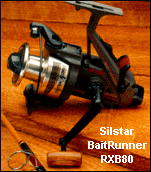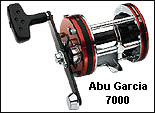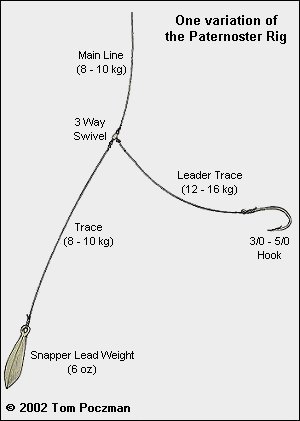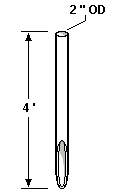Surf Fishing for Beginners
Rods & Reels
Beach or surf fishing can offer to those fishers who are land based, a measure of excitement parrallel to that of boat fishing. The equipment needed is reasonably affordable, and readily available from most tackle stores.
Tackle shops sell balanced rod and reel combinations in a variety of lengths and weights. My first ever surf rod setup was a rod/reel combination, costing about $120. This was about 15 years ago, and prices have only marginally risen, where you can now pick up a decent combo for about $170 - $200. There's no single rod and reel that will be perfect, but a 10 to 12 ft rod is a good length to work with. Look for a rod that is not too soft, meaning, one with too much flex in the tip, and one that can handle up to 6 ounces of weight to hold a rig on the bottom.
The notion in having a two piece rod as opposed to a whole one, is deemed now a days as being attributed purely to preference. There are slight advantages in having a one piece rod, where by the curvature of the rod during its load and consequent cast is more natural, offering the best performance from such a rod. However, given the fact this offers only a marginal advantage, two piece rods are preferred, as they are more comfortable to manage in transit and easier to store.
 Reels on the other hand, are another story. There are essentially two types of reels you can buy, those being a Threadline (spinning, egg beater) or Overhead. Threadline, or "egg beaters" as they are sometimes commonly referred to, are usually the norm for first timers to Surf Fishing, or fishing for that matter. Some good brands like Daiwa, Shimano and Silstar offer a huge variety in models and sizes in these types of reels. Reels on the other hand, are another story. There are essentially two types of reels you can buy, those being a Threadline (spinning, egg beater) or Overhead. Threadline, or "egg beaters" as they are sometimes commonly referred to, are usually the norm for first timers to Surf Fishing, or fishing for that matter. Some good brands like Daiwa, Shimano and Silstar offer a huge variety in models and sizes in these types of reels.
Overheads are commonly used by people who have become proficient in casting. Overheads do offer the advantage to the fisherman, in contributing to a better level of accuracy in casting, as well as a further distance being achieved in the cast. Overhead reels also require a special Overhead rod. Such a rod has essentially has more eyes on the rod as opposed to a normal surf rod for threadline reels.
 The extra eyes on an overhead rod are definitely needed, as the fishing line from an overhead reel tends to spool off more easily and quickly than a normal threadline reels. The extra eyes on an overhead rod are definitely needed, as the fishing line from an overhead reel tends to spool off more easily and quickly than a normal threadline reels.
As a consequence, Overheads are more prone to bird's nests, hence the need for familiarity in casting techniques and reel control, where one can develop a smooth casting stroke, a good sense of timing for the release, and what experienced anglers call an 'educated thumb'.
The ultimate in a beach rod, is where you have your rod custom made. Not a cheap option, but it does offer you the advantage and comfort in having a rod and butt pre-made to suit you height and arm length, and offers you the functionality to determine the rod's characteristics, such as tip strength and flexibility.
It also allows you to choose its aesthetic quality, so as to fully personalise the rod.
Rigs
 Most of the time you will be fishing with pieces of natural bait such as cockles, squid, garfish, or mullet, using a single or ganged hook combination. Most of the time you will be fishing with pieces of natural bait such as cockles, squid, garfish, or mullet, using a single or ganged hook combination.
Pre-made and packaged rigs are extremely versatile and good for several species of fish such as Flathead, Aussie Salmon, Mulloway, and afford the opportunity to change hook sizes, styles and sinkers easily, to suit the species of fish, and conditions of the sea. Some shops sell them with the hooks and sinkers already attached.
As you develop your skills in managing rigs and tackle, you may even want to try making some of your own rigs. A classic and favourite of mine is the triple ganged, chemically sharpened 4/0 hooks, ideal for most surf fishing rigs.
It requires you to know how to tie a Paternoster rig, Snelled Knot, Figure Eight Knot and a Half Blood Knot. Making your own rigs also offers you the chance to dwell on thoughts of strategies in hooking into a big one, and giving you the opportunity to enjoy the preparations involved in any fishing excursion !
Baits
A standard practice in fishing is to maintain the freshness of your bait, keeping it out of the sun, and in an esky with ice. Fresh bait will always attract fish. The more successful beach fishing locations are renown for their remoteness, and chances are that the closest bait shop is many kilometres away. So prolonging the freshness of your bait is well worth the effort.
Presentation of your bait is also an important factor in enticing a hook up. Garfish and Mullet can be filleted and cut into chunks or strips. Squid works best when cut into thin, wedge shaped pieces that imitate a swimming bait fish in the current. When using whole fish like Pilchards or Garfish, they must appear natural on your rig when ganged.
Luring
 It's also a good idea to take a few artificial lures to the beach. The most favoured brand on the market are the Halco Twisty Lure (70 gms) or the Gillies Lure (85 gms), retailing for about $8 - $10 each. Occasionally, fish will school up and feed very actively right in the surf, within casting distance. This is especially true of Aussie Salmon, especially during the early and late hours of the day. It's also a good idea to take a few artificial lures to the beach. The most favoured brand on the market are the Halco Twisty Lure (70 gms) or the Gillies Lure (85 gms), retailing for about $8 - $10 each. Occasionally, fish will school up and feed very actively right in the surf, within casting distance. This is especially true of Aussie Salmon, especially during the early and late hours of the day.
When retrieving lures, they need to appear like a agitated bait fish in distress, quickly swimming away from a potential predator.
 When you buy a lure, think about buying a spare, or even two. The worst thing imaginable is to have fish all around you in a feeding frenzy, and watching your line break due to a snag or a slipped knot. If you have a "bum bag", use it to carry some snap swivels and your spare lures. When you buy a lure, think about buying a spare, or even two. The worst thing imaginable is to have fish all around you in a feeding frenzy, and watching your line break due to a snag or a slipped knot. If you have a "bum bag", use it to carry some snap swivels and your spare lures.
A standard practice I employ when surf fishing, is to take two rods down to the beach. My main beach rod is used with a Paternoster Rig and bait, and while the rig is out doing its work, I then work the shore line with a lure on a small 6ft ugly stick. This type of activity can offer you a dual chance of a hook up with any predatory fish.
If you have different coloured lures, try and swap them around while luring. A variety of colours work differently under various weather conditions, so a selection of coloured lures to choose from is good practice.
 Also a pair of long nosed pliers won't go astray, sometimes needed to remove deep-throated lures. Also a pair of long nosed pliers won't go astray, sometimes needed to remove deep-throated lures.
Nor will a knife or clippers, incase some emergency maintenance is needed on your rig or line.
I also carry a small flat head and phillips head screw driver, incase of maintenance to my reel.
You may want to check out the Tackle Talk section at fishSA.com, for additional information on Bait Presentation, or review an article on the Basics of Lure Fishing in the Reviews section.
Accessories
 A crucial piece of equipment for beach fishing is a sand spike. You can easily pick one up from a tackle store, but a cheaper alternative which works just as well, is to make one up yourself from PVC tubing. A crucial piece of equipment for beach fishing is a sand spike. You can easily pick one up from a tackle store, but a cheaper alternative which works just as well, is to make one up yourself from PVC tubing.
A home made sand spike consists of a 4ft piece of 2" OD diametre PVC pipe, cut at an angle on one end, and then used by shoving down hard into the sand.
The butt of your fishing rod is then inserted into the pipe after your well timed and executed cast !
Just remember to cut the pipe at an angle, a steep angle, so that it can be easily driven into the sand. (OD = Outside Diametre)
You should never lay the rod and reel down in the sand, as sand tends to gravitate into every crack and crevice of a fishing reel, and damaging it.
 After a day's fishing, a gentle freshwater wash down of the rod and reel will minimize salt corrosion. After a day's fishing, a gentle freshwater wash down of the rod and reel will minimize salt corrosion.
 It's prudent to spray the reel and rod guides with a moisture displacer, such as WD40 or RP7, and wipe off the excess with a cloth. It's prudent to spray the reel and rod guides with a moisture displacer, such as WD40 or RP7, and wipe off the excess with a cloth.
Conclusion
Some people may miss out on the fun of surf fishing because they don't know where or how to begin, and may be slightly intimidated by the salty looking veterans that can cast a country mile. Those veterans have honed their skills through years of practice and catch fish from the beach when rookies sometimes come up empty.
My answer to you in this regard is, don't be afraid to get out there and give it a try. It's an experience I'm sure you won't regret.
You may also want to read up on some other articles I have written about Casting, Lines and Lures.
 Fishing Tip : Fishing Tip : |
|
| Why not contact fishSA.com about your Fishing Tip |
|
|